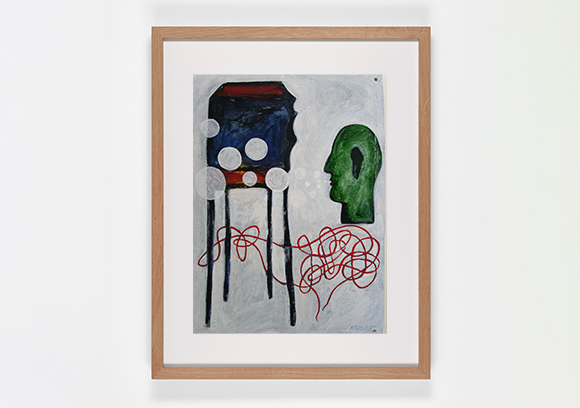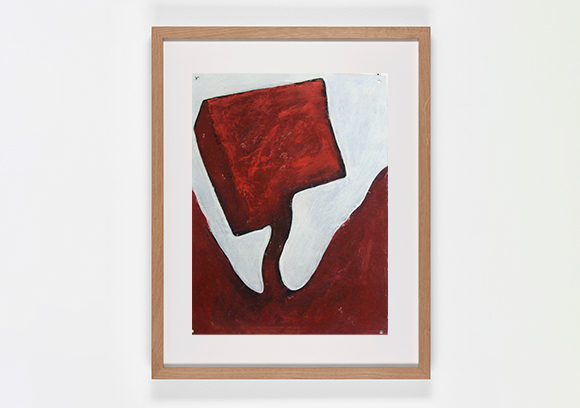| |
|
|
01.
| Antibiotics |
| |


Paintings started in 1993. series of 141 paintings on paper.
Exhibition view from Paris-Casa, suites marocaines, Couvent des Cordeliers, 1999, Paris.
Artist's collection, France.
'' They all combine abstraction and figurativeness, contained and container, as well as the different states of matter: liquid, solid
and gas… In this way, they constitute a sort of chemical laboratory
where the motif and mounir fatmi’s plastic language are progressively developed. ''
Studio Fatmi, January 2018

Antibiotics
Exhibition view from Paris-Casa, suites marocaines, Couvent des Cordeliers, 1999, Paris.
Artist's collection, France.

Antibiotics
Exhibition view from Paris-Casa, suites marocaines, Couvent des Cordeliers, 1999, Paris.
Artist's collection, France.

Antibiotics
Exhibition view from Paris-Casa, suites marocaines, Couvent des Cordeliers, 1999, Paris.
Artist's collection, France.
|
|
|
|
|
|
« Antibiotiques » est un ensemble important de peintures accumulées depuis 1993. Décrites par l'artiste comme un « projet de vie », elles mènent une réflexion sur la création artistique qui s'inscrit dans la durée. Si les œuvres de cette série sont exposées de temps en temps, elles ne sont pas au départ destinées au public et appartiennent avant tout à leur auteur, qui les envisage comme « un carnet de notes ». L'alphabet chromatique des peintures se compose essentiellement des couleurs primaires associées au blanc. Celles-ci s'associent en une palette émotionnelle qui rend compte de fluctuations émotionnelles. Elles font le lien entre le champ des émotions et désirs informulés, et leur expression et leur mise en forme.
L'appellation médicale attribuée à l'ensemble des peintures médical évoque si l'on s'en tient à sa définition courante une action de blocage de la toxicité d'un certain matériau. De quel matériau s'agit-il ici ? Est-il question d'éléments autobiographiques douloureux ? Ou encore des pouvoirs qui s'exercent au détriment de l'individu, souvent évoqués dans d'autres œuvres : pouvoirs du langage, des images, de la société de consommation et des médias, de l'architecture ou de la politique, tous teintés d'idéologie, informant - ou déformant les esprits des individus avec lesquels ils entrent en relation.
Le motif se compose et se décompose dans chacune des peintures. Les premières d'entre elles font apparaître et disparaître un verre, puis une figure ou un visage… Elles mêlent toutes l'abstrait et le figuratif, le contenu et le contenant et les différents états de la matière : liquide, solide ou gazeux… Elles se constituent en ceci comme un laboratoire de chimie où le motif et le langage plastique de mounir fatmi sont peu a peu mis au point. « Antibiotiques » est une expérimentation dans la durée. Elle élabore une pharmacopée très personnelle où l'action « bloquante » est obtenue par différentes techniques d'effacement et de recouvrement. Réactualisés dans l'œuvre de mounir fatmi, ces procédés fondent une stratégie nommée « réalignement de l’objet ». On la retrouve notamment appliquée dans la Peinture « Rencontre », hommage à Jackson Pollock, où un tapis oriental est entièrement recouvert par des traits de peinture blanche et se voit ainsi désacralisé. La stratégie artistique suivie par l'artiste a pour but d'annuler le statut initial de l'objet. Elle produit une toile vierge où s'élabore ensuite le vocabulaire plastique de l'artiste, dont les termes visent le minimum de charge idéologique et le maximum de charge émotionnelle et de pouvoir expressif, et poursuivent le désir de constituer un langage plastique libre et autonome.
Studio Fatmi, Janvier 2018.
|
|
« Antibiotics » is a large collection of paintings gathered since 1993. Described by the artist as a « life project », they carry out a reflection on artistic creation spanning a long period of time. The works in this series are exhibited from time to time, but they weren’t originally destined to the public and belong to their creator first and foremost, who considers them a « notebook ». The chromatic alphabet in the paintings essentially comprises primary colors associated with white. They are combined in an emotional palette that aims to transcribe emotional fluctuations. They connect emotions and unspoken desires to their expression and shaping.
The medical term attributed to this collection of paintings is commonly defined as the blocking action on the toxicity of a given material. What material is this? Are we talking about painful autobiographical elements? Or the powers that are exercised to the detriment of individuals, as often evoked in the artist’s other works: the powers of language, of images, of the consumer society and the media, of architecture or politics, all tinged with ideology, informing – or deforming – the minds of the individuals they interact with.
The motif composes and decomposes itself in each painting. The first ones show a glass and then make it disappear, and then do the same with a character or a face… They all combine abstraction and figurativeness, contained and container, as well as the different states of matter: liquid, solid and gas… In this way, they constitute a sort of chemical laboratory where the motif and mounir fatmi’s plastic language are progressively developed. « Antibiotics » is a long-spanning experiment. It elaborates a very personal pharmacopoeia whose « blocking action » is obtained through the use of various erasing and covering-up techniques. Updated in mounir fatmi’s work, these processes are at the heart of a strategy dubbed « object realignment ». It is applied, among others, in the painting « Encounter », homage to Jackson Pollock, where an oriental carpet is entirely covered with lines of white paint, thus finding itself desacralized. The artistic strategy followed by the artist aims to cancel the object’s initial status. It produces a blank canvass on which can be developed the artist’s plastic vocabulary whose terms attempt to carry the smallest possible ideological charge and the largest possible emotional charge and expressive power, as they pursue the desire to create a free and autonomous plastic language.
Studio Fatmi, January 2018. |
|
|
|